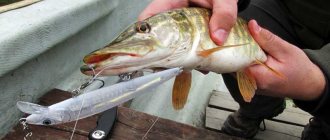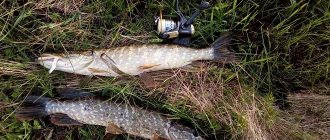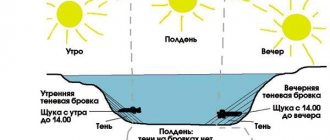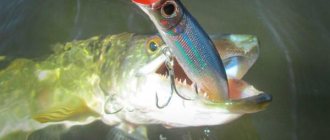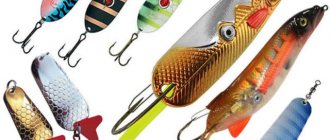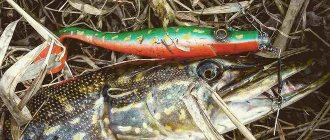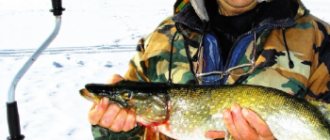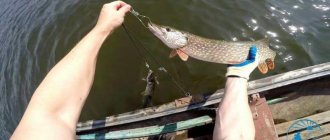Which ones are suitable for shallow water?
Many fishermen believe that large predators are found only at depth. Therefore, they do not consider fishing options in shallow water. Actually this is not true. A trophy specimen may well bite in the shallows. Very often, large pike perch or pike go there to feed on bleak. This is where you will need the same wobbler designed for shallow depths.
In order to determine which bait is best suited for shallow water, you need to know by what parameters they are classified.
In terms of buoyancy, all wobblers are made in three versions - floating , sinking , and hovering in the water column (suspenders).
Floating – this is the designation for baits that do not sink; otherwise, they float. The packaging is usually marked with the Latin letter F. Among them there are both weakly floating ( SF ) and quickly floating ( FF ).
Sinking – this group includes all sinking baits. But there are some nuances here too. In addition to the letter S, the packages contain abbreviations such as SS (slow sinking ) , ES ( extra sinking ) or H ( heavy ). The last two mean the same characteristics, but for some companies they are different.
Suspending are wobblers with neutral buoyancy. They are designated by the abbreviation SP. In reality, this rarely happens; usually the wobbler floats up slowly or sinks slowly.
Now let’s decide which wobblers are suitable for shallow water in terms of buoyancy.
A floating wobbler or suspender would be ideal here, since a sinking one collects all sorts of debris at the bottom.
In places with various snags, you should try to take only floating models ; when you stop, they will float up and you will be able to get around the snags, avoiding snags.
Also, each bait has its own working depth or so-called depth , which must be indicated by the manufacturer.
According to this criterion, baits are classified into surface , mid-depth , and deep-sea .
We will be interested in wobblers with a dive of 0.5 -1 m , they will be considered shallow, usually encrypted with the letters SSR (Super Shallow Runner) or SR (Shallow Runner) .
You can also use baits with a depth of up to 1.5 meters . They are designated by the letters MR (Medium Runner) .
The following types of wobblers are classified as surface ones:
- poppers;
- gliders;
- chuggers;
- crawlers;
- walkers.
Lures of medium depth include:
- jerkbaits;
- rattlins;
- darters.
Which wiring is best to use in shallow water? The most common is twitching . This type of wiring is suitable for surface baits, which can provoke even a very passive predator to attack. To do this, perform a series of jerks, not too sharp, observe the behavior of the wobbler, it should seem to be scouring from side to side.
When fishing in shallows, you can also use uniform wiring .
Suitable for lures that have their own game, such as cranks, chuggers, rattlins. This is done by uniformly rotating the coil. And also uneven (“stop and go”), suitable for any type of bait.
My working wobblers for shallow water
When the water in shallow water warms up and underwater vegetation begins to grow wildly, young fish are attracted here. This is due to this. That in shallow water there is enough food in the form of small insects and algae, there is somewhere to hide from danger. Following the fry, predatory fish also come here. For the spinning angler, fishing in vast shallow areas is of great interest because it is full of excitement and leaves a fantastic experience. Of course, in order to successfully fish in such conditions, you need appropriate bait, which will be discussed.
The specificity of fishing in such areas of the reservoir has its own peculiarity. The carpet of algae begins at a depth of about 0.5-0.7 m. This depth will be the working fishing area. It makes no sense to use jig baits and iron, since tufts of grass will cling to the bait on each retrieve. Therefore, as experience shows, floating wobblers with minimal depth will be the most effective.
I’ll start my review, perhaps, with baits whose immersion depth is from 0 to 30 cm. Jackson Dead Float 80, made in Japan, weighing 8 grams. A floating model that becomes a suspender with a leash. It goes deep to a maximum of 25 cm. For me, this minnow has earned the honorary title of one of the best and most catchy wobs for pike in shallow water. True, they mostly take small (up to 1.5 kg) spotted torpedoes. Probably from a small size - only eight centimeters. The vob flies very far, the price is quite affordable, which makes this model popular. The wobbler has its own game, but like any mino it reveals its potential on a jerky retrieve with pulls. With a leash, when the wobbler becomes a suspender, a long pause with a small twitch of the tip of the spinning rod brings phenomenal results. This trick is especially effective when the fish is passive and does not respond to regular baiting. One day I had to watch through polarized glasses how a small pike followed a fish almost all the way to the boat, and then returned to its original parking place. On the next retrieve, the pike came out again. When the predator went for the bait, I stopped the wiring, and the bait was motionless for several seconds. A slight movement of the tip of the spinning rod was enough for the toothy monster to attack the wobbler.
The next killer in my box, working at minimum depth, is the Jackall Tiny Magallon SR. The wobbler is made in the best traditions of the manufacturer, it is two-piece, has high catchability, and flies far. Among other things, it is indescribably beautiful and natural. Magallon does not like sudden movements of the rod - on a slow retrieve with smooth jerks and pulls it reveals itself to the fullest. Otherwise, the front tee gets caught up in the leash. By the way, if you use a steel leash, you need to remove the factory tees and equip the wobbler with lighter ones made of thin wire. Any predatory fish, both large and small, can be caught with this bait. I forgot something... Oh, yes, the price. A few years ago, this vob could be classified as elite class (due to the fabulous price). But now the cost has dropped by half, which makes this wob available to a wide range of anglers. P.S. Catchability and workmanship remained at the highest level
Rating of the best
For pike
Lucky Craft Pointer 100 SSR – this wobbler is the shallowest in its class.
It has a noise chamber with balls, but does not have a magnetic long-casting system. This is compensated by its weight, which helps the wobbler have good flight qualities. It scours the water column quite well, thereby provoking a passive pike to attack.
During retrieval, the bait moves at a depth of 10–15 cm, and when it falls into the water it immediately floats up.
Daiwa TD Minnow 60 SP is a classic model of the “minnow” class; despite its small size and weight, it has good flight qualities thanks to the long-distance casting system.
The bait is perfectly balanced and shows good performance in any current and with any retrieve. The wobbler is equipped with high-quality hooks that reliably detect fish and minimize the number of escapes.
Megabass Vision 110 is a floating surface wobbler that can rightfully be called legendary in pike fishing.
The length of the bait is 11 cm, weight – 14.2 grams, working depth – up to 1 m. Vision 110 is equipped with a noise and long-distance casting system. The main wiring is twitching.
For zander
Zip Baits Rigge 90 F is the largest model in the “ridge” class.
Thanks to the balancing system with tungsten weight, it has excellent flight qualities. Length – 9 cm, weight – 9.5 grams, working depth – up to 1 m. Control over the bait is not lost with any type of wiring.
Yo Zuri Crystall Minnow 70F is a floating wobbler that showed excellent performance in shallow riffles favored by pike perch.
The length of the bait is 7 cm, weight – 5 grams, depth – up to 0.8 meters. By letting the wobbler float up, you can bypass underwater obstacles, avoiding snags. This model allows you to take long pauses, which has a positive effect on the bites of a passive predator.
Zip Baits Orbit 110SP-SR is a universal wobbler that works great in twilight fishing conditions for pike perch.
Due to the long-distance casting system, it makes it possible to be at distant points, directly from the fishing spot. Length – 11 cm, weight – 16.5 grams, working depth – 0.8 – 1 meter.
For perch
The Jackall Flat Fly 50SP is the ideal suspender for jerk retrieves.
During normal execution, it rolls from side to side; during twitching, it cuts from side to side. The cast is almost without overlap, quite far, despite its weight. Length – 5 cm, weight – 2.3 grams, working depth – 0.2 – 0.6 meters.
Zipbaits Rigge 35 F is a floating wobbler, suitable for shallow waters, and will surprise any angler.
The size of the bait is 35 millimeters, ideal for perch of various sizes. Weight – 2 grams, working depth – 0.3-0.8 m. It can be carried out either by twitching or by uniform wiring.
Owner Cuetiva SP – this high-quality wobbler, according to the authors, has a certain mystery in attracting fish.
The bait in a unique way saves you in the dead of the night, helping you get away from the “zero”. Length 50 mm, working depth -1.2 meters. It is important to remember that 50% of bites on this unusual bait occur during a pause while reeling in the fishing line.
For som
Jackall Cherry 55 - pot-bellied crankbaits, very high-quality baits, achieve the best results in overgrown shallow bays.
Working depth from 0.3 to 1 meter. The size is relatively small from 4.4 to 4.6 cm.
Yo-Zuri 3D Crank is a universal model, has a sweeping game, but at the same time maintains its trajectory.
Can be used when fishing at medium depths in any current.
Strike Pro Buster Jerk – the first generation baits are 15 cm long, the second – 12 cm.
The wobbler is made of plastic and is shaped like a fish with a wide body. The bait is easy to operate and is well suited for beginner fishermen. There are balls inside the body that, when inserted, create additional noise, attracting a predator.
For chub
Smith Camion SR is an excellent wobbler for shallow rivers, since its working depth is up to 0.8 meters.
With a relatively small weight of 2.5 grams, it casts well. The length is 3.2 cm. It has good high-frequency play. The wiring used is uniform with stops, or alloy technique.
Salmo Hornet F is an excellent wobbler with a length from 25 mm to 4 cm.
Working depth is from 0.5 to 1 m. In the floating version it has a shallow short blade. Shows a good game. Simple and accessible to everyone, it is an old-timer in the fishing goods market.
Pontoon 21 Red Rag is a good quality bait with active action.
You can also note the amazing casting accuracy and control of the bait during any retrieve. Length – 3.6 cm. Weight from 5.7 to 6.1 grams. Retrieving can be done at any speed, it will not affect the performance of the bait in any way. Depth from 0.2 to 1.2 meters.
Andrey Pitertsov: TACTICS OF SELECTING THE BEST LURE FOR PIKE
Last time we talked about choosing the best bait for catching perch. Now it's time to discuss the “pike topic”. There is an opinion that pike attacks almost everything, without being particularly picky. This opinion is partly confirmed by practice.
Indeed, a hungry aggressive predator is equally likely to attack a popper or crawler moving along the surface, and a jig bait moving at high speed in the water column. There are a lot of different incidents and unusual situations in fishing. For example, a predator’s attack on an eared load and a double suspended on it without bait (when trying to pull out a poacher’s net). And to a greater extent, it is the spotted one that is capable of such sometimes inexplicable “feats”.
That is, pike is truly one of the most unpredictable predators in central Russia. It is possible to get a pike bite with almost all types and classes of spinning lures. However, not everything is so simple and transparent. Pike, like any other predator, has a “mood” - changes in activity, preference for one type of bait over others.
It’s not difficult to catch an active predator, but it’s rare that a spinning rod gets a really good bite. As a rule, a predator has to find its own approach in a given specific place, alternate between many baits, and resort to various tricks so as not to be left with nothing...
Consequently, for each specific case there is a set of baits that will be the best in the given specific conditions. I propose to talk about these baits. And the main thing is what to start from when choosing one or another.
Of course, I will try to look as broadly as possible (as far as my own experience allows) at the list of different lures and methods of catching pike.
As in the article about perch, I suggest breaking down all the material, mainly based on the fishing depth.
Tips and tricks
One of the most colorful and spectacular is fishing with shallow wobblers, since the fish are caught near the shore of the reservoir. In order to see all the movements of the bait and the reaction of the fish to it while retrieving, do not forget to wear polarized glasses . Without them, it is difficult to see everything that is happening in the water.
It is especially interesting when a predator passes near the bait several times, but is afraid to take it. This means one thing, that he doesn’t like something and the fish moves away. Confusion, tension and disappointment - this is a small palette of the sensations that fishermen experience at such moments.
How to deceive a predator? When answering this question, all available baits are used, colors and wiring change. If a predator is nearby, then a couple of casts are enough to determine how it reacts to a particular wobbler.
When a fish approaches the bait, but turns away at the last moment, it means that it is not the model itself that is scaring it away, but most likely the color of the bait, or some nuances of the game. Then you need to check other sizes, change colors, or slightly change the wiring: slow down, pause, or maybe speed up first or come up with something else...
And now, you have another favorite bait in your arsenal, proven by your own experience.
Most often, shallow-water wobblers are used in places overgrown with grass, where pike and perch like to sit in ambush. It would be advisable to use larger baits, since the predator often attacks a wobbler comparable to its size. But it happens that the more capricious the bite, smaller baits are needed.
Since there is little depth in the grass and good illumination, baits of faded colors will work best - golden, silver, copper, “perch-like”, even matte red and black.
In the morning and evening hours when there is a calm, sometimes fishing in smaller places with a wire sliding along the water surface brings a trophy.
It is best to start fishing with a uniform retrieve , but if it does not want to take the bait, then you can use periodic stops and freezes. When the predator is completely passive, we introduce some aggressiveness into the wiring. It is very good to use twitching wiring, since it consists of a series of jerks and twitches of the fishing line with pauses, it can quite provoke the fish.
When fishing for chub, an important point is the color of the bait, try to change the color more often, and also set the original color after an hour or two, because the fish may start to take it, and then stop biting again. This is how capricious the chub can be.
What are the advantages of fishing with shallow water lures?
Very often, small-sized wobblers, which pike love, also prefer to attack other predatory fish; this can be beneficial in quantitative terms, when several species of fish can be caught with one wobbler.
They can be caught from the shore, and quite large specimens are often caught.
You can also control the fishing process with your own eyes.
Features of fishing for pike in shallow water
- We lead the bait near the thickets. Windows among the vegetation in the summer heat are the only option to catch grass.
- Availability of disguise. Pike parking areas can be located under the shore - literally two meters away. As soon as the angler approaches the shore, the pike immediately becomes alert and may leave the parking area. We begin to fish nearby areas, standing behind cover and not approaching the edge of the shore.
- We take several types of bait with us. Pike are not averse to eating a good suspended wobbler. But already the first cast can bring a hooked tuft of grass. The lightweight spinner also works great for pike and is less likely to get caught on grass and snags.
- If there are no bites after three trips, we change the bait or fishing location. In some cases, the predator may simply be inactive or the bait may not be within the predator's field of vision.
Fishing for pike in shallow water in the grass gives good results with silicone bait. If you have tried several types of wobblers, vibrating tails, twisters and spinners, fished several different places, but still no bites, most likely the problem lies in the lack of activity of the predator. In this case, it is better to know when the pike is most active and follow the “Fisherman’s Calendar”.
TAGS:
How to learn to catch pike and perch with wobblers at depth
After shallow-water wobblers, it’s easier to move on to deep ones.
The simplest and most versatile option here is to use sinking wobblers that work in a depth range from half a meter to the bottom. If you start leading a sinking wobbler right away, it will go half a meter to a meter from the surface. If you let the bait sink deeper, that’s where it will go. Try both uniform and uneven (including stepped bottom) wiring. However, snags and losses are already quite common here.
And finally, it will not be difficult for you to master diving wobblers, and with them all the subtleties of uneven and especially stepped retrieves. Start along the edge of the algae, and then gradually increase the depth.
That's it - you are already a master! All that remains is to polish and diversify your experience and pass it on to others.
The best wobblers for pike and perch
A wobbler, in my opinion, is the most catchy bait in the vast majority of cases. You just need to choose that specific wobbler that will outperform all other baits under these conditions.
However, many fishermen still do not master this new fishing technique. They are confused not only by the high price, but also by a certain difficulty in choosing and using various wobblers. Indeed, no other bait has such a variety of shapes and colors. And the fishing itself is not entirely familiar. How to figure everything out, especially if there is no authoritative tipster?
These fears are indeed well founded. After all, a wobbler is far from a universal bait. On the contrary, many models have a very narrow specialization. Therefore, your wobbler will become the most catchy bait only when you select it correctly and skillfully use it in your specific conditions. In other words, for a given fish in a given place and at a given time, you need to find the optimal wobbler.

